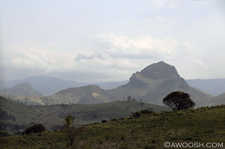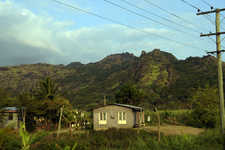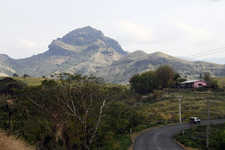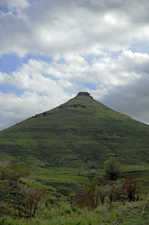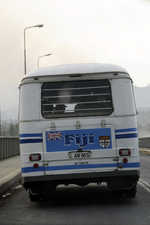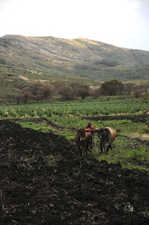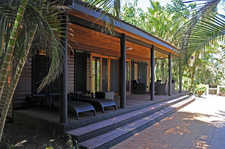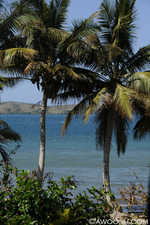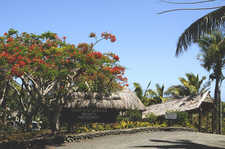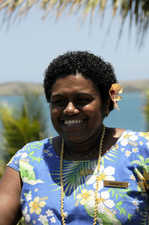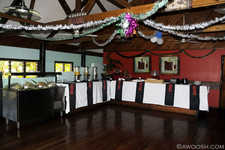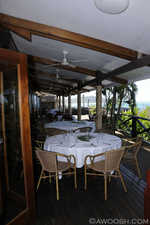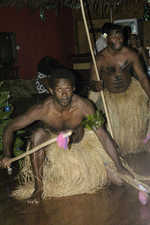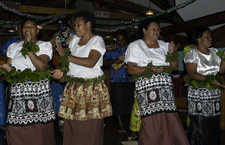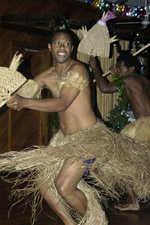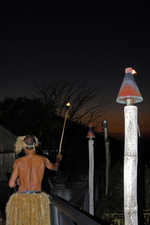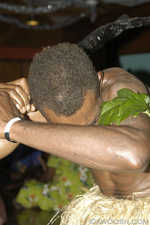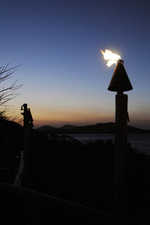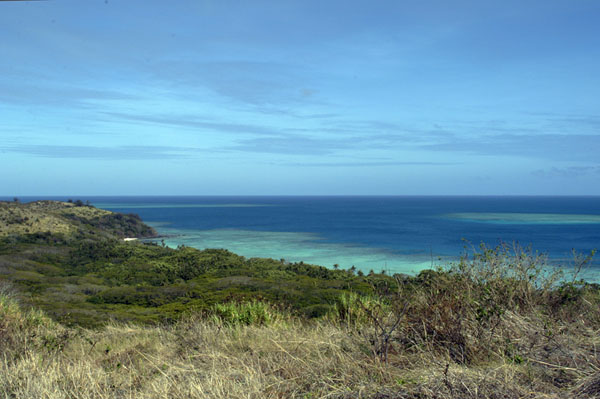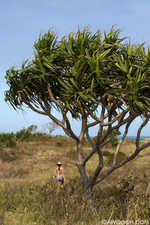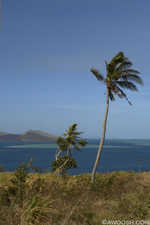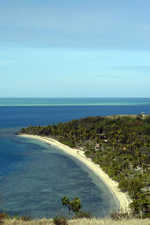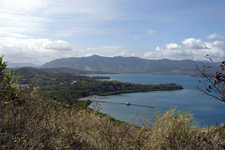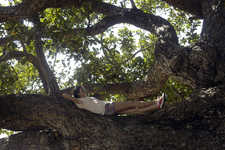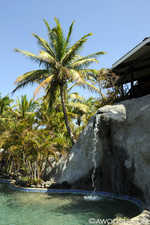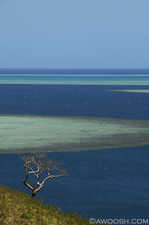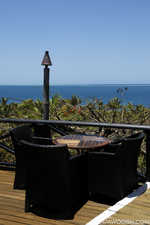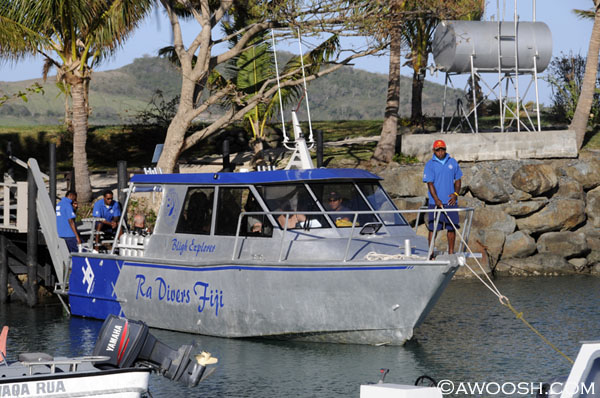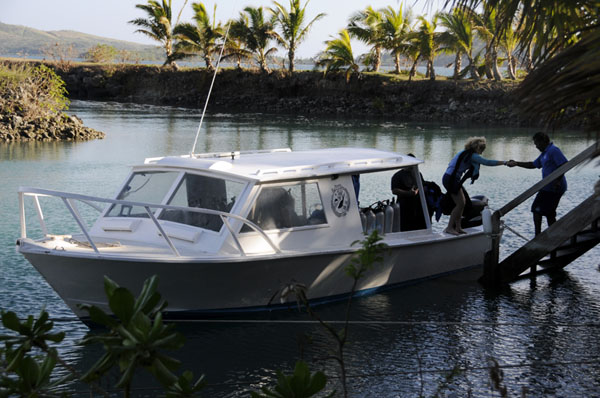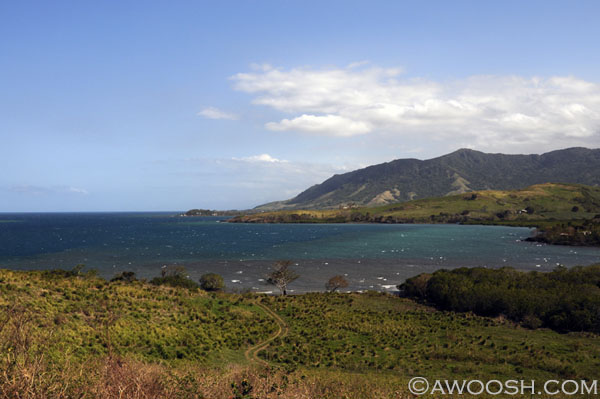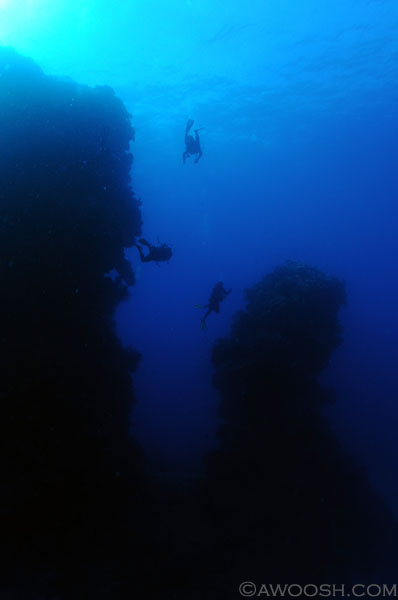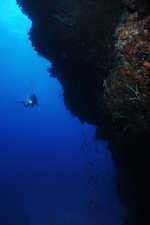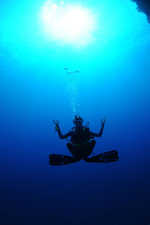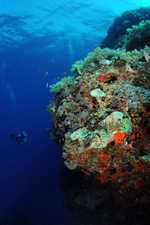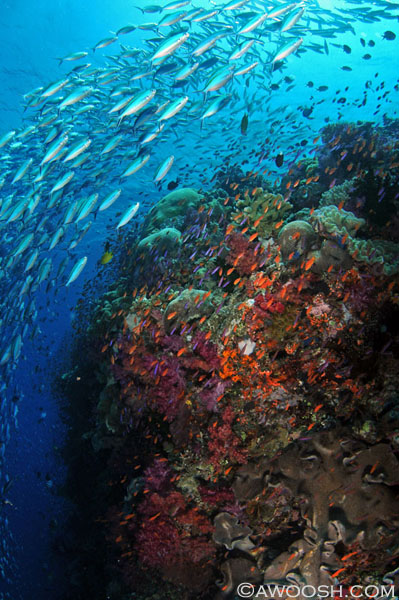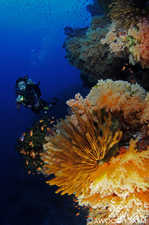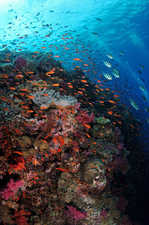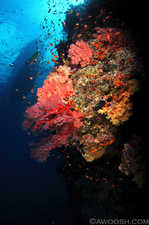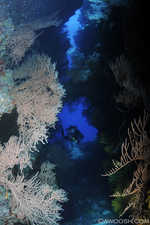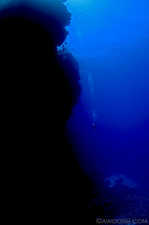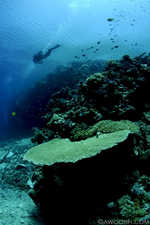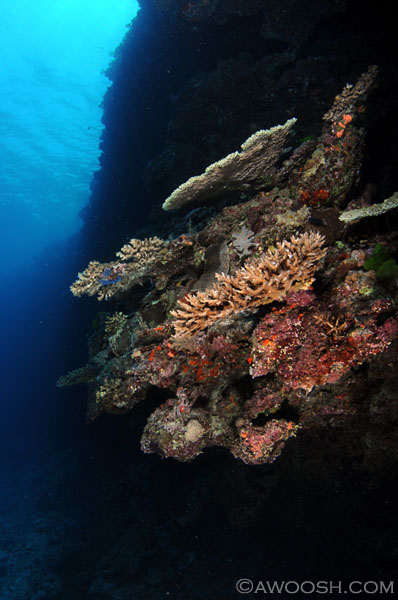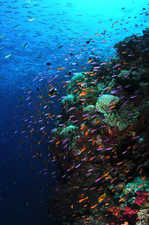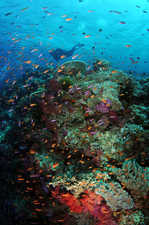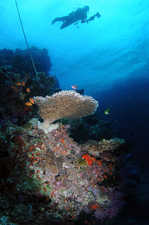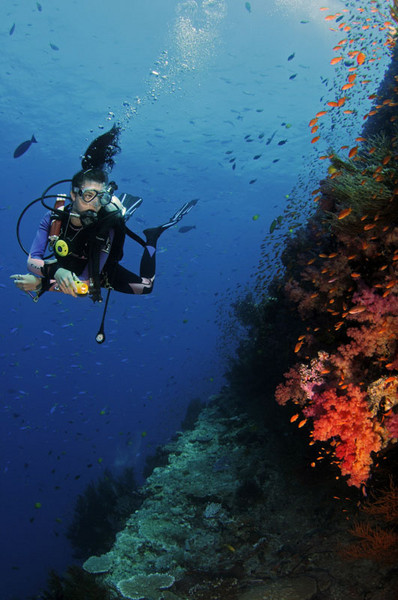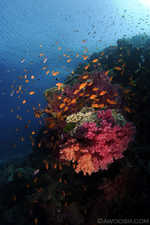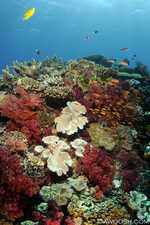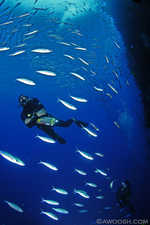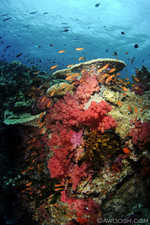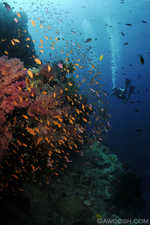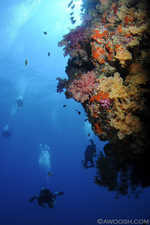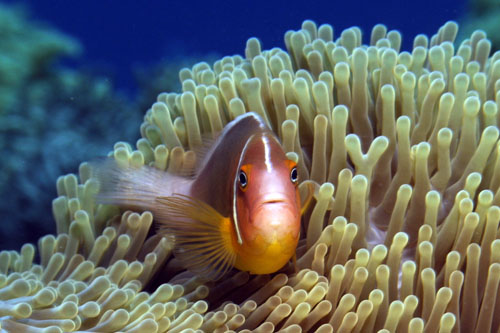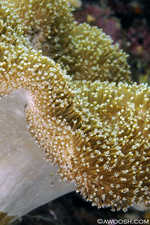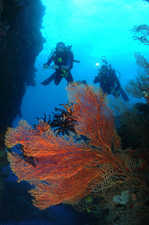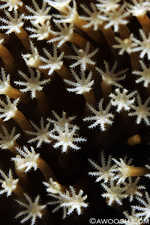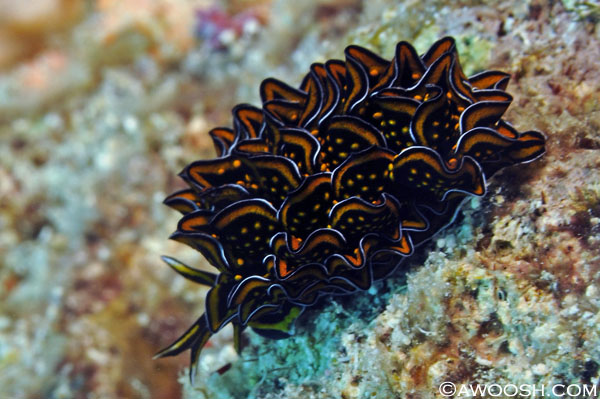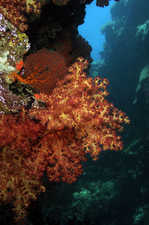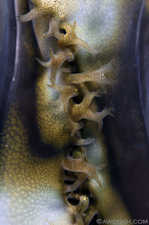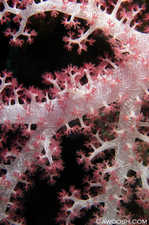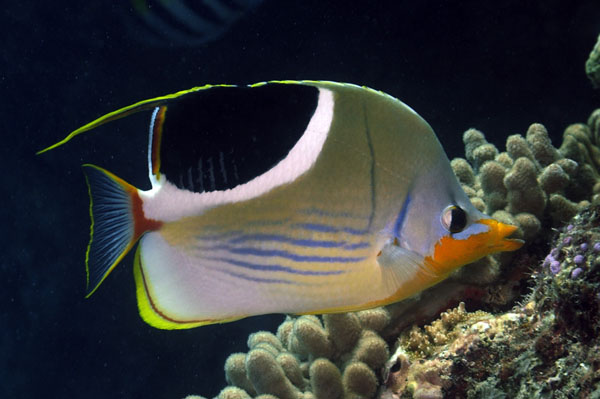FIJI 2009 Text & Images by Judy G Important Update: Since writing this comprehensive trip report, I have returned to Wanananvu on two more occasions - March 2011 and February 2013. I am happy to report that the resort remains as charming as it was for this visit in 2009. The big change is that there is now a new on-site dive operation - Dive Wananavu Fiji - currently managed by Chris and Vicky Liles. It is a huge improvement over Ra (which I write about in the following 2009 report). To read a more recent trip report about this wonderful location, and to read a comprehensive review of the new on site dive op, please follow this link.
We have recently returned from a 10 day stay at Wananavu Resort, over Christmas, diving with Ra Divers. We are very experienced divers (well over 1000+ dives each, warm, cold, current, sharks - the whole enchilada) and were accompanied by our teenage daughter who has something in the neighborhood of 150 dives, some of them in very challenging current conditions (Komodo and Thailand). Mr G and I had previously stayed and dove in this part of Fiji in June 2007. On our last trip, we stayed at Nananu Beach & Dive Resort on the nearby island of Nananu-i-ra, and we dove with Kai Viti Divers. Sadly, both are no longer in business. At that time, Kai Viti did not take us out to the Bligh Waters, as they said water conditions were too rough. As an aside, the Bligh Waters are famous not only for their extraordinarily beautiful reefs, but for their frequent chaotic water conditions. The Bligh Waters are the wide, relatively shallow channel between the southern large main island of Viti Levu, and the northern large island of Vanua Levu, and are completely open to the elements. The channel is not unlike the one between Komodo and Flores in Indonesia, which is also famous for wild and woolly ocean currents. Given the probability of moderate to strong ocean currents on any given day or dive (and conditions can change very rapidly), and the possibility of large wave conditions that make getting back on the boat difficult and perhaps even dangerous, plus the very real possibility of divers surfacing and being carried a long way from the dive boats, plus some very steep and deep terrain, I do not believe that this diving is appropriate for new divers, except in the most benign conditions. Crystal Diver's owner (an op that was previously in the area) was lost during a dive in these waters, along with a student, and their remains were never found. He was a dive instructor and an expert diver. The good news is that the diving close in to the resort on Sailstone Reef is quite beautiful - unfortunately this December bands of strong wind from a near miss cyclone really stirred the water up, so these sites were quite murky during our stay. On a previous trip they were blessed with good viz, and I would rate them good to very good – I surfaced after every dive on these reefs sporting a big grin and having bagged lots of images. To see these reefs in better days, click here. These are the reefs for newbies - short boat ride, usually benevolent surface conditions, not too deep, and minimal current. After hearing positive reviews from friends who had stayed and dove at Wananavu before jumping on the Aggressor live aboard (out of Suva), we decided to return to this part of Fiji, with the hopes of diving the famous Bligh Waters this time around. We were fortunate that Wananavu had space for us over the busy Christmas season, as our trip was a last-minute escape, booked in late November. Rachel, the booking manager at Wananavu, was a responsive and helpful contact, and we booked our trip with her directly. She also took care of the diving reservations, as Wananavu offers inclusive packages for meals, airport transfers, accommodations and diving with Ra Divers.There are other accommodation options in the area, all more backpacker style. As I understand it, Ra Divers will pick up at all the ones in the area. I stayed at one of these joints – MacDonald’s Cabins - in my footloose early twenties, when I first spent some transformative time on Nananu-i-ra Island, after beaucoup partying on Beachcomber Island. That was my first trip to this part of the world – way back 1982 (feel free to do the math ;^) Nananu-i-ra hasn’t changed much since back then, in fact, Fiji, outside of the few urban areas, feels the same. But back then, you had to bring all your own food supplies across from across the water from Raki Raki to Nananu-i-ra with you, as there were no eateries or little stores on the island, as there are now. Back then, the Fijian driving the little skiff would throw out a hand-line on the commute across to the island, and haul in a big silver fish for his trouble. Back then, the generator turned off at 10 pm. Back then, you could spend all day on a rambling, palm-lined sandy beach, and never see another soul. Back then, I was afraid of lurking shadows in the sea, and never even ventured into the water off of this beautiful island. It has been an amazing full circle that brings me back, as a diver and photographer – things I never envisioned myself doing back then.
Fiji (Nadi airport) is serviced non-stop from LAX six days a week by Air Pacific. Recently, Continental started a non-stop flight to Nadi from Honolulu, which is great news, as this means many folks will be able to fly the whole journey on the same US carrier. On Air Pacific out of LAX, it is about a 10 hour flight (give or take, depending on head and/or tailwinds). It is a 747, with in-the-back-of-the-seat-in-front-of-you in-flight entertainment, complimentary meal service (X2 – and I highly recommend submitting a special meal request for a fresh fruit plate – everything else offered looked a bit nasty to me), a reasonable checked bag policy (2 bags - 23 kg each), a crazy carry-on policy (one bag, 7 kg total weight – good luck to all the photogs out there ;^), free in-flight cocktails, pillow, blanket, earphones, a night flight amenity kit (earplugs, mask, socks, toothbrush & paste), and a generally very kind and accommodating Fijian crew. With regards to carry on weight enforcement, it seems erratic. I had a very unpleasant experience trying to carry on a few extra pounds in my conforming sized bag on the 2007 trip, and let’s just say it ended up with me layering on every possible piece in it, including my prescription scuba mask, in order to appease the whippersnapper at the gate ;^) For cattle class flying (they really pack 'em in), it was not unpleasant, even with the rather intimate secondary pat-down outbound of Nadi for all passengers following the terrorist incident on Christmas Day, per new TSA requirements for US destination flights. Biz Class upgrade is available (assuming space available) at the airport for US$750 - a bit too rich for 3 of us. I peeked in the Biz cabin, and it looked spacious, but the seats are old school so are not flatbeds when reclined. We transited through many Fijian villages, and a few larger population centers, including Lautoka (aka Sugar City) and Tavua, the gold mining town. Rolling fields of sugar cane dominate, with the occasional dwelling or livestock or Fijian village cropping up on the horizon.
The driver was happy to stop at an ATM on the way, and in Tavua so we could stock up on bottled water (unnecessary as it would end up, as the resort has safe n delicious drinking water available) and a couple of cases of the ever-tasty Fiji Bitter (beer), to stock our fridge in our room at the resort. It helps to plan ahead, as a trip into Raki Raki from the resort by taxi is both a bumpy ride and quite spendy. I would rather be diving.
If I had to sum up the best things about this place, they are: great diving a day boat ride away, intimate resort, wonderfully warm Fijian staff, beautiful gardens, gorgeous dining deck, and great brew on tap ;^) Accommodations We stayed in a beachfront two bedroom “villa” (#40), and it was very nicely appointed – a sitting area with upholstered wicker chairs, a round table near the kitchenette (that made for a kickass camera table), aforementioned kitchenette, equipped with some well-worn cutlery and crockery, and a small combo fridge and freezer where we could keep the beer cold and frosty up some glasses. There are two bedrooms separated by a closet block – both air conditioned (though we never needed it), ceiling fans and pine paneling. One room has a queen bed (with a very firm mattress) and the other has two singles. There was a CD boom box in the living room – had we known, we would have brought some tunes on CDs to play. Sadly, there was no iPod dock on it. The bure has a very functional (but not particularly luxe) bathroom suite – vanity, big laundry sink (made for an awesome camera rinse), toilet, shower, and a washing machine! The shower had good water pressure and a seemingly unlimited hot water supply. Divers care about these things :^) Out front a huge covered deck with another round table and nice chairs, and two chaises. Then a patio. Then a bit of garden that looked a bit whacked after the recent cyclone and could have used some water and tidy up. Then a drop down to some grass. Then a bit of a beach. Then the sea. Then Nananu-i-ra, not far across the channel. Beautiful.
I would not rate these particular accommodations as 5 star (more 3.5), but they were comfortable, clean, spacious, and ideal for families. There are several other sorts of bures (Fijian word for house) available on the property, including luxe honeymoon bures with plunge pools, budget-minded garden-facing bures, and some beachfront bures - some much closer to the beach than we were, with an inviting hammock strung out in front of them. Power supply is 220-240v, and there are two adapters you can use – the one with prongholes like this ( \ / ) or the one like that, with a third straight pronghole like a nose underneath it. There were adequate, but not ample, outlets available in our bure. Food & Beverage Meals at Wananavu were fair to very good. There is a fresh sheet daily, and a standard menu as well, so there was always something new to try, or something good to revisit. The cuisine is generally geared to western tourists – and included such standards as hamburgers & fries, pizza, pasta, fish & chips and main course salads. I would give special mention to the soups, and the local fish prepared in various ways, which were always fantastic. The beef, however, not so much... A la carte prices appeared to be quite spendy, so I was glad that we had bought a meals included package, which includes breakfast continental buffet, plus a la carte eggs made on order, two course lunch (entrée and main), and three course dinner (entrée, main and dessert). The (included) breakfast buffet is adequate - fresh fruits, juices, toast, muffins, dried cereals, coffee and tea. There is an expanded a la carte breakfast menu available (included in the all-inclusive meals option) which includes eggs done any style, french toast etc. Service at the restaurant was good - the Fijian staff is friendly, welcoming and pretty much wonderful – but occasionally erratic (a few long waits for food to appear). It was extremely busy at the resort during our stay over a peak time, so I think that might explain it. Besides, what's the hurry? You're on holiday in Fiji.
Bar prices are fair, but not cheap, with daily featured concoctions. If you are booking a unit with a fridge, you might be wise to ask your driver to stop in Lautoka or Tavua on your drive up the island to stock up on beer or wine, to enjoy on your private deck. The road in to the resort from King’s Highway – several kilometers of it – is a rutty, bumpy, 4 wheel drive kind of affair. The nearest town is Raki Raki, about ten km away, where you can buy basic provisions. Wananavu put on a terrific Christmas lunch – turkey, ham, stuffing, mashed potatoes, Christmas pudding – the real deal. We also enjoyed a traditional Lovo feast one evening – root vegetables and a poor piggy wrapped in leaves and cooked in a pit in the ground in the Fijian tradition. I understand that they do this once a week. Kava, at least the watered down version they share with the guests, is on deck every night. The Christmas feast and the Lovo were both served buffet style. Regular meals at lunch and dinner are served at the table. During lunch and dinner live entertainment was on deck – usually a Fijian trio on guitar and ukulele singing traditional Fijian tunes. One evening a traditional Fijian dance was put on display. The men dance (and they do look quite fierce as they leap around in grass skirts, brandishing spears) and the women dance (demurely, mostly with their arms and hands and grass fans). In the background, many staff members sang traditional Fijian songs and played instruments, beautifully.
On Christmas Eve, the choir from the local town came and sang carols on the dining deck. It was wonderful, but I was sad that they weren’t with their families on Christmas Eve. Many Fijians are quite religious – the indigenous Fijians gave up their ritualistic, bare-breasted, cannibalizing ways after the missionaries landed in the mid-1800s, and convinced them of a higher power. The Fijians I have met are extremely family-oriented, and few live very far away from their villages of birth. Community is very strong, and religious community is a pretty big part of their lives. When we booked our stay at Wananavu, Rachel informed me that there would be no diving on Christmas Day. Boat diving, that is. Shore diving was available (more on that later). She explained to me that Christmas is a very important Fijian occasion, and that they dive guys would not be working that day as they would be going home to their families. Unfortunately, a large American group, apparently unaware of local traditions, had demanded that they boat dive Christmas Day as part of their package. So off they went, probably not understanding the cultural importance of this day, and what it really meant that foreigners could come and ask the crew to be away from their families and communities. The dining deck itself is lovely. It overlooks the gardens below, and then out over the glorious, shades-of-azure ocean. It is a beautiful spot. There are some great tables on the west and south sides of the deck that make a great place to inhale the beautiful sunsets over a Fiji Bitter or two. Most tables offer sun cover, in one form or another. There is also ample eating space indoors, but the doors are always open in nice weather. There were a few mozzies, so we covered up in the late afternoon and evening, and dosed any exposed bits with a hit of DEET. Every evening, as the sun sinks into the horizon, a wooden drum sounds from below, and then a grass-skirted and bare-chested Fijian leaps onto the dining deck and leaps along and lights the tiki torches along its edge. Dining under those tikis, with the Fijian soundtrack in the background, with a temporarily captive butterfly of a teenage daughter, sipping a frosty beer and reliving the day’s dives? Priceless.
Activities and Amenities There is a small gift shop off the lobby where one can purchase sunscreen and other basic toiletries, Fijian sulus (colorful wraps), shirts, sundresses, sandals, jewelry and knickknack gifty things. There is a computer in the gift store for use by guests (for a fee), but it was out of order for the duration of our stay. Every day, available activities are posted on a chalkboard in the lobby area. Some of the offerings were: specials on spa treatments, local village tour, tour of local waters by boat, snorkeling trips, bamboo river rafting excursion, touring a local black pearl form, and several others, most of which were at an extra charge. There were also skiffs with drivers available to ferry passengers across to Nananu-i-ra for beach picnic and snorkeling, for a nominal fee. We went across on Christmas day, visited my old stomping grounds at McDonald’s cabins, and the ghost town that is Nananu Beach & Dive Resort, and then hiked up high onto the ridge, to go looking for the wild horses that still roam the island, and to suck in the beautiful views. Grassy equine droppings confirmed that the horses were there, but we never did see them. I suspect they hang out in the cool mangroves during the day – the only time we saw them on a previous trip was late in the afternoon. It was a beautiful 3 hour hike, with a swim in the bay to cool off while we waited for the skiff to come back and fetch us.
The resort has two beach areas - neither of which are fantastic, but are more than adequate for kids wanting to toddle around in the water. There are ample chaises on the palm beach near the Activities Center, as well as plastic kayaks to borrow. There is one well-kept tennis court, a small, but quite nice swimming pool area with a waterfall (the gardener in me says get some plants growing on that less than beautiful concrete wall). There is a spa featuring massage and beauty treatments. We didn’t go on any excursions, and none of us tried the spa, so nothing I can report there. All in all, we very much liked the resort, and are already planning our return.
We had a few minor issues with Ra, but overall, I’d rate it a pretty good op with good crew and good boats taking divers out to what is, in my experience, the best land-based diving I’ve ever done. The Good on Ra Generally good equipment (boats) - Bligh Explorer - capable of 16 divers or so (that makes it a crowded boat when fully loaded) - one engine only (inboard) - it did crap out one day (luckily we were on the other boat) and they had to limp back to Wananavu - I don't think the large group on board got in the water that day. Swim grid jump entry. Dual ladders to exit. W/C on board. Covered, open to the back cabin that will keep most divers out of the spray when underway.
Small boat (Phantom) - dual outboard Suzuki 175 HP four stroke engines - so the thing really goes (faster than the large boat). Somewhat more open to the elements, but still a closed cabin to about 1/2 back. Can take 12 divers - but that is a very crowded boat, people are going to get wet in rough conditions, and there are not enough tank racks for two tanks per, so extra tanks got stacked on transom, which made the boat very low on freeboard in big seas. Most days we were 5 - 8 passengers - only out with 12 for two days, and we were there over Christmas when the resort and Ra were very booked. Backroll entry. Slightly tricky ladder exit. Crew was willing to let divers roll out of their gear and hand it up to make ladder egress a bit easier, and insisted on it one day when we experienced big seas, even in the lee of the reefs out in the Bligh. Getting smacked on a bucking ladder with your gear on can really hurt.
For both boats - One small camera rinse bucket that I avoided, as I don't like my rig bumping elbows with others, and we had some very rough seas, so I think the bucket was mostly salt by the time we were done anyway. Instead, I wrapped my camera in a wet towel to avoid letting the sun bake the salt on it (and to buffer it a bit from the bumpy ride) and then gave it a primo rinse once back at the resort. Snacks (usually cake or cookies and fruit), and hot chocolate were dished during SI's, plus drinking water was available, but we preferred to bring our own reusable water canteens. Towels were provided. Consistently good fills on the AL80s. Oxygen on both boats, life jackets, working radios (or cell phones, not sure which, but I know they had communications). As an aside, those are the minimum safety standards for any dive op I use. I think that Ra Divers were quite motivated to take divers out to Bligh as the nearby Sailstone reef sites were very splooged up due to a cyclone the week before. I dove the Sailstone reefs last time I was there (2007) and they were unrecognizable in the murky viz. In the Needs Improvement Column There were only two events that caused us any concerns. On one site (I think Mellow Yellow), per usual procedures, they tied off the boat to the bommie. I had done several circuits of the reef so I knew where the boat was, but at the end of the dive, without any info from DM, they apparently untied the boat and were cruising back and forth just off the reef. That was disconcerting - I hate surfacing anywhere near a moving boat. Mr G and P3 were still at the top of the bommie taking pix and did not realize the boat was gone - I could not get to them to let them know as there was a lot of current over the top (I had already waved buh-bye), and I was way low on gas. Another diver was swimming out in the blue trying to get to it. I found this situation to be quite dangerous. I surfaced just off the bommie and signaled to the boat where the other divers were. Not a huge thing, but I don't understand the logic. I did not make an issue out of it at the time, just coached the other divers if that ever happened again to surface over the (shallow) reef, as it is unlikely the boat would run over it. The second issue was, I believe, due to poor communication. A Japanese group (6 divers) was booked by a wholesaler out of Japan who apparently errantly gave December 2010 as their arrival. Well, they arrived 2009, and the boats were already pretty full. A representative of Ra (not Ned, the Manager, but an underling named Bob) sought out our group (the three of us, plus a nice couple from the US and a cute chick from Toronto), at lunch, to tell us that Wananavu (ie Rachel) had made a mistake in the booking, and that the Japanese divers would be on the boat for the morning dives for the next few days, and then we would be taken out in the afternoon for our tanks. We met with Ben and Rachel, the Managers of Wananavu, and then Ned, the Manager of Ra Divers, and were politely assured that we had been misinformed and that we would be going out in the morning after all - to the Bligh if weather permitted. Next day we show up, and there are 12 on the small boat. The Japanese group was only there for 3 days of diving, so it was just a couple of days of rubbing elbows. No biggie, and we ended up getting to know and enjoy some of the Japanese divers, but, in my opinion, the whole incident was a bit mishandled. Then again, maybe they thought we wouldn’t mind sleeping in and going out in the afternoon. I dunno. It would be good if Ra had a fallback boat in case of mechanical failure of one of their two boats during busy times, and to cover them in a situation like this. The first day we had 12 on the boat was the day we turned back half way to the Bligh. The next day, they put the Japanese and us on the large boat, I think to guarantee that the Japanese would get out to Bligh at least once during their stay (it was their last day of diving). The large American group cried like babies when that happened ;^) I don't know why they thought they should be entitled to always having the large boat, but apparently that was their thinking. Fiji time - the boat only left once on time. Instructed to be on the dock at 8 a.m., it was often 8.30 or even 8.45 before we were out of there. The only day we left on time was the day we elected to do a 3 tanker in the Bligh. The late departures may have been partly due to the large volume of divers and some switcheroos of passengers and their gear that seemed to happen daily. And late starts are not unique to Fiji – they seem to be the norm in many tropical destinations. Rachel of Wananavu advises that there is no promise that divers will go to the Bligh, but that every effort will be made if conditions allow, and the majority of divers on the boat want to go. That could be a major disappointment for folks showing up when the op is not well-booked, or when there are differing agendas amongst the passengers. On the plus side, they do not charge extra to make the run to the Bligh, whereas Kai Viti Divers did. Ditto afternoon and night dives - they will only go (if I recall correctly) if they have 6 as well. But, assuming no narsty weather, the local reefs are nothing to sniff at. I can understand Ra’s reluctance to go with a small load – it is a significant distance and fuel costs for such a big run are no doubt the reason they impose a minimum number of divers.
Surface Intervals on the boat dives are set at 45 minutes – we find that a bit tight on air, but dove conservatively and did extra long safety stops to make sure it would not be an issue for us. Most of the reefs we dove had fantastic stuff growing right up to 15 feet, making the last 15 minutes above 20 feet a real pleasure. Our average dive was well over an hour - with many newbies done around the half hour mark, they had long SI's ;^) Us, um, not so much... Only a couple of divers on our boat used Ra's rental equipment - it looked to be in decent condition and I heard no complaints. I read a very negative review on Trip Advisor from December 2009 about the lack of rental gear for a large group - that is something that I would think is really challenging for most smallish dive ops like Ra, and wonder if this request was given to Ra at time of booking, or on arrival. People with the requisite experience to dive the Bligh Waters would likely be people owning their own dive equipment, or people who should consider renting reliable equipment from their local dive shop and bringing it with them. Borrowing life support equipment in developing countries, especially when it is calibrated in an unfamiliar way, is always sketchy. The griper mentions that the divers in question showed their computers to their DM as a way of signaling remaining air supply. Assuming these newbies were not diving air integrated computers, they would have been wiser to show their spg and/or give a low on air sign instead. I also question that diver's perception that no matter what the conditions, they should have been taken out to the Bligh. There is absolutely no obligation for Ra Divers to take divers out there if they think the conditions are too dangerous for either the boats and/or passengers, or if they feel the level of experience of the divers is not adequate. Having two divers run out of air and panic on the surface on their first dive likely did not entice Ra to take on the extra responsibility of dealing with these same divers in Bligh conditions, and unfortunately, when you travel as group, you are only as strong as your weakest link. The same diver also rails on about divers running out of air and how the DMs were at fault. A diver running out of air is not the fault of the DM. A diver who goes down on a tank that has not been changed over is not the fault of the DM. Every diver needs to be responsible for monitoring their own air supply and consumption, and doing a pre-dive check to make sure the equipment is fully operational. If unable to get the attention or co-operation of the DM in a low on air situation, divers should go to the surface (ideally with their buddy) while they still have enough air to do a safety stop and to surface with several hundred PSI in their tanks. Divers should carry a highly visible surface marker for this reason. You can save your life for $24.95 by getting yourself one of these, which will not lay down in wind or high waves as a safety sausage might, and are very visible from great distance. A DM in most locales I’ve visited is typically a group dive guide and critter-finder, not a hand-holder. If requiring special attention for whatever reason, divers should be prepared to hire a private DM to look after them. In our experience, all Ra DMs we had briefed that divers should let them know when they were down to a half a tank. At that point they would return to the mooring area, and then send divers up as they got low on air. A certified diver who can not surface in a buddy pair without a DM holding their hand, is, in my opinion, is a diver who needs to go back to school. Rant mode off ;^)
I fear I do not possess the adequate superlatives, nor the images, to do justice to Bligh Waters diving. But I’m gonna try. The Bligh is out there. Way out there. Ra Divers says that the Phantom (their smaller, faster boat) can get to the remotest sites they dive in 45 minutes. At top speed. With twin Suzuki 175’s. On flat water. This, unfortunately, was not our experience. It was blustery in Fiji when we arrived, and it kept it up for the duration. Moderate morning winds (and Wavananu was situated in the lee of them) blew themselves up to seriously gusty winds in the afternoon, when whitecaps formed in the protected channel between Wananavu and Nananu-i-ra Island. Palm leaves rained and tiki torches got blown out at dinner. I suspect that this part of Fiji may be windy quite a bit of the time – it has been every time I’ve been there, and that covers early November (1982), June (2007) and this past December.
So, every Bligh dive became a white water adventure. Or a nightmare, I guess, depending on how you do on rock 'n roll boats. I am fortunate in that I do not get seasick on open boats, even in wallowing seas. But get me on a live aboard where I have to spend time inside? A Scopalamine patch is my savior. The boats pick up in resort’s very protected, man-made marina (bummer to think of the coral reef that was no doubt sacrificed for it). Then, if going to the Bligh, we’d head east, out the passage between Viti Levu and Nananu-i-ra and its chain of islets. On the way out there are natural channels between some very shallow reefs, and you can see the coral formations just below the surface as you whiz by. Once past the last of the barrier islands, things would get interesting. You’re in the Bligh Waters – the huge, shallow channel separating the two big islands of Fiji. The topography of this north coast of Viti Levu is epic - craggy volcanoes, wild shore, few signs of civilization. And off this coast, there is nothing but chunky big blue water, for miles, and miles, in every direction, except for one small island (really just a hunk of rock), sticking up, near which lurk some killer dive sites. To get to the closest site to Wavanavu, Wheat Field, was a turbulent hour and some long ride. The farther away from land we got, the rougher it became and the slower the boat needed go to navigate the peaks and the valleys of the angry sea. A few people, who were compelled to puke, did a great job of heaving discreetly, over the lee side. The pilots rode those waves with panache, and with the frequent drenching of the folks sitting on the hindquarters of the boat. Wheat Field Wheat Field is a formation out in the middle of freaking nowhere. There is no attached reef (unlike many of the sites we dove). It’s just twin towers of coral – the big one, and its sea fan infested sidekick. The bommie hits the floor at about 150 feet. One of the divers on our boat dislodged her mask on her first roll in, and it sank into the depths before she could grab it. One of the DMs kindly went on a recovery mission. It is reported that he failed to communicate to his herd that he was going deep to look for it, and one his followers (a great girl) told me at one point, she looked at her gauges and went Whoa! Note to self: follow the leader, but keep your brain in gear ;^) The mask was never found, and so we leant the maskless diver one of our spares for the duration. An extra mask and computer in the dive bag can come in handy sometimes… So, about Wheat Field. Set up near the front of the boat (not my decision), I was last in. I signaled I was good, my camera was handed off, and I exhaled to start sinking. I was fudging with the camera as I am wont to do as I descend and fin towards the reef – watching closely for bad bubbles, then extending the strobe arms and firing up the beast. Mr G and P3 were together just ahead of me. Finally, I got my face out of the camera and had a good look around. This was my first view:
The viz was stunning – now, this is what we came for. I could see the entire bommie structure, all 130 glorious vertical feet of it. And the one beside it. It was a veritable wow. The site gets its name from the proliferation of wheat-colored gorgonians and soft corals and anemones infesting the top.
Not much else up there, except for a few anemones and their flirtatious friends.
Like all the bommies we dove in Fiji, it was mostly hard corals on one side, with a few reef tropicals cruising about, doing what fish do. And then you go around the corner, and it is blam! – ridiculous – waving, pulsing with color and life - pinks and yellows and whites and purples and reds and whites and billions of orange and pink little fish (anthias) keeping time in their mesmerizing dance. Schools of chevron barracuda lurk just off the reef, wary of the bubble-makers. The occasional reef shark saunters by. Big schools of fusiliers hang out just off the reef, at times forming a dense school that shoots up over the reef when spooked by patrolling predators. We ended up doing three dives at Wheat Field, as it is the closest Bligh site to Wananavu, and so was favored during the rough seas.
Soft corals abound in massive gardens, with the occasional sponge or hard coral somehow finding a toehold amongst them. Some of these colors only come alive when lit with a light or a strobe (the pinks and the reds), but others jump out even in the dimmer light of depth – the whites and the yellows, the greens and the blues. There are so many fish that they often get in the way of a picture. Trying to capture that motion and that activity with images became my mission du jour. There was quite a bit of current on this dive, around the side as we headed to the soft coral garden, and beaucoup over the top which made anemone fish shooting entertaining. Mellow Yellow If I had to pick my favorite site from our trip, I think Mellow Yellow would be it. It had it all - lush proliferations of soft corals (mostly yellow - hence its name) and really rockin' fish life.
Garden of Eden Garden of Eden is a beautiful reef dive, with a cut through the reef that is decorated with beautiful sea fans and some steep walls falling from the shallows to about 50 feet. I was having some trouble with strobes on this dive, so need to go back to really do the garden justice ;^)
Potluck Potluck was the third of our three dive day out in the Bligh. It is a long ridge of reef, as opposed to a bommie, and once again one side was predominantly stands of hard corals, while the other side was festooned with soft corals, and of course clouds of anthias and fusiliers.
Instant Replay Instant Replay is a drift dive - and was the only dive we did where we did not return to a fixed mooring. It was a stunningly beautiful site. After dropping in on top of a half dozen reef sharks, we drifted with the current along the edges of highly colourful shallow walls and round bommies. Most of the dive was above 80 feet, which allowed for a nice luxurious drift. Then the surprise - a swift kick in the pants of current as we rounded the corner on the reef to the pre-arranged pick up point. Some of the less experienced divers that day were clearly freaked by the sudden blow of current, and were literally climbing the wall trying to get out of it. Little did they realize that the current was coming from both over the top of the reef, as well as around the corner, and their only salvation was to let go and get blown towards the boat, grabbing the granny line before they got blown off the back. I would estimate the current running around 3 knots - not insignificant, and the most we encountered while diving in the Bligh Waters. On this trip, I was trying out a new camera (a Nikon d300), which allowed much faster shutter speeds than the d100 that preceded it. On this dive, I was pushing shutter speed to try to freeze the anthias, but alas, I pushed it too far, and so sadly, all of my images from this dive have a dark side - the shutter speed apparently too quick for the strobes. Black Magic Mountain This is a signature dive in the Bligh Waters. When I asked various crew members what their favorite sites were, they were pretty much unanimous in their enthusiasm for Black Magic Mountain and E9 (which was inaccessible during our stay due to rough sea conditions). It is a wondrous site - a large coral bommie, indeed shaped like an underwater mountain, with gorgeous coral formations and lively fish action.
Sailstone Reef Sailstone Reef is actually a series of reef structures much closer in to Wananavu than the Bligh Waters. As I mentioned previously, they were pretty splooged up due to a recent storm, so on the days we were dropped in there, I set up for fish portrait and macro. Following are a series of images taken on various sites in the Sailstone Reef system. To see Sailstone diving from better days, you can check it out here.
Wananavu means 'wonderful' in Fijian. Bligh Waters diving, Wananavu resort, the Fijian people, and their beautiful country? They all fit the definition. Fiji Article Text © Judy G — February 2010 FIJI REPORT LINKS Awoosh Fiji 2009 Gallery
|
